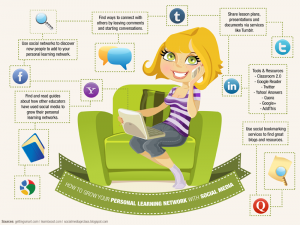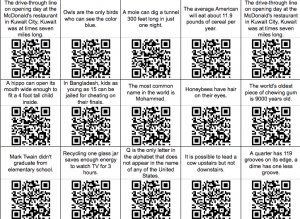Got Engineers, America? Have Your Kids Study Lego Bricks in School!
Twitter in the K-8 Classroom
Check Out This Amazing Interactive Concept Map Of Over 350,000 Websites
“The Internet Map encompasses over 350,000 websites based in 196 countries, which are clustered according to about 2 million mutual links between them. Developed by a small team of seemingly (Singapore based?) Russian enthusiasts, the interactive Internet map is an ‘attempt to look into the hidden structure of the network, fathom its colossal scale, and examine that which is impossible to understand from the bare figures of statistics.’
Every circle on the map stands for a unique website, with its size determined by website web traffic. Its color depends on the country of origin, with red for Russia, yellow for China, purple for Japan, and light-blue for the US.”
STEM Resources
- Women in Science, Technology, and Mathematics ON THE AIR!:Listen to radio shows about the past, present, and possible futures of women working in the STEM fields, courtesy of WAMC Northeast Public Radio and the National Science Foundation.
- Committee on Women in Science, Engineering, and Medicine:Since 1990, the National Research Council has hosted the Committee on Women in Science, Engineering, and Medicine (CWSEM), which organizes events dedicated to promoting exactly what the name states.
- STEMinist:Stay on top of news, views, trends, and research about women in STEM through profiles, articles, networking opportunities, and plenty more media.
- Women@NASA:NASA supports an initiative encouraging women and girls to pursue careers in the aerospace industry, with plenty of recruitment and career opportunities (including SISTER) meant to close the gender gap.
- TechWomen:Presented by the U.S. Department of State’s Bureau of Educational and Cultural Affairs, TechWomen promotes collaboration between American, Middle Eastern, and North African as a means of furthering science and technology as well as cultural harmony.
- Association for Women in Science:AWIS partners with other organizations and businesses in order to address issues of women working in the STEM fields and keep young girls interested in studying the related subjects.
- STEM Equity Pipeline:Women and minorities are incredibly underrepresented in the STEM fields, and this partnership between the National Advisory Board, Extension Services, and multiple local and national organizations and businesses hopes to change that unfortunate reality permanently.
- Association for Women in Mathematics:This organization’s goals revolve around encouraging young girls to pursue mathematical studies if they enjoy them, as well as promoting the efforts of novice and established women with careers in the field.
- Digital Sisters/Sistas Inc.:For women in the STEM industries interested in education, Digital Sisters/Sistas is a great nonprofit reaching out to “traditionally underserved” child and adult students.
- The National Science Partnership for Girl Scouts and Science Museums:More activism-oriented professionals looking to volunteer and encourage younger generations of girls to enter the STEM fields might want to check out the engaging lessons provided by this partnership.
- National Center for Women & Information Technology:Whether an established career woman or an activist and educator looking to nurture a love of IT in young girls, the NCWIT makes for a great organization to get involved with and promote workplace diversity.
- Women in Astronomy:Head to the Women in Astronomy blog for updated news and commentary about issues pertaining to astronomy, astrophysics, physics, and the ladies who practice them.
- Society of Women Engineers:When it comes to promoting STEM education amongst young girls and college students as well as celebrating the contributions of female engineers, SWE is one of the best resources both online and off.
- FemaleScienceProfessor:Issues pertaining to women in academia and the sciences alike push to the forefront of this popular blog by the anonymous Female Science Professor.
- Agora:Bookmark Agora for multimedia resources regarding the latest women in STEM stories, including the yearly winners of the L’Oreal-UNESCO Awards and information about fellowships.
- 4000 Years of Women in Science Biography Listing:University of Alabama provides a plethora of capsule biographies of some important women in STEM history, so stop by and pay respects to the groundbreakers who made today’s opportunities possible.
- Women in Science: A Selection of 16 Significant Contributors:Despite the title, this e-book by The San Diego Supercomputer Center also celebrates female mathematicians and engineers with major influence over their respective fields – even if their male peers refused to acknowledge them.
- GWIS: Graduate Women in Science:The Sigma Delta Epsilon fraternal organization launched at Cornell in 1921 and continues offering fellowships and support to the female graduate students belonging to their 17 chapters across the United States.
- Science: It’s a Girl Thing!:It’s not just American organizations compiling their resources to make the STEM fields more equitable for women; the European Commission launched Science: It’s a Girl Thing! to start destigmatizing perceptions of science, math, and engineering as purely masculine realms.
- Women in Science:Unfortunately, it looks like The Smithsonian Channel isn’t currently airing Women in Science, but the site remains active and packed with a few fun educational goodies, like comics and quizzes.
- WEPAN Knowledge Center:For female engineers, the WEPAN Knowledge Center proves an essential bookmark chock full of resources, networking opportunities, and other essentials regarding getting ahead.
- The UKRC:STEM-related businesses looking to recruit more women often call on The UKRC for consultations on increasing workplace diversity along gender lines.
- ADVANCE:Stop at the National Science Foundation to apply for awards, grants, and fellowships specifically intended to further women’s presence in STEM industries.
- Under the Microscope:The Feminist Press publishes blogs and books about the numerous ways in which women participate in science, technology, engineering, and mathematics historically and contemporarily.
- Anita Borg Institute for Women and Technology:No matter what visitors need – be it research or a community or event information – the Anita Borg Institute for Women and Technology has it available for networking and promotional purposes.
- MentorNet:MentorNet pairs up established female and minority science and education professionals with up-and-comers to ensure they know how to navigate businesses predominantly populated by white males.
- National Institute for Women in Trades, Technology and Science:This organization devotes itself to closing the gender gaps in both STEM and law enforcement, with tons of information and research for businesses and schools hoping to increase their gender diversity.
- Women of Color Research Network:The National Institute of Health presents an initiative promoting women of color in the biomedical field, from showcasing and funding their research to offering up networking opportunities and other great events.
- I Was Wondering…:Women in STEM with daughters or female students – or who volunteer with kids – should turn those teens and tweens onto I Was Wondering … and teach them about the lives and findings of some of the great ladies of science.
- Biographies of Women Mathematicians:In this Agnes Scott College database, almost the entire history of women in the mathematics comes alive through biographies, timelines, and maps.
- Women in Technology Sharing Online (WitsOn):Students and teachers at participating schools connect with some of the leading women in technology for excellent one-on-one opportunities, all facilitated online.
- 100 Women Leaders in STEM:STEMConnect celebrates the 100 women currently working in STEM who are keeping their industries moving forward through a massive e-book and a reception honoring honorees’ contributions.
- Association for Women in Computing:Consisting of institutions and individuals, the AWC offers up networking opportunities, mentorships, and more for female students and professionals who love the computer sciences.
- Women in Global Science & Technology:Check out what this amazing nonprofit is doing to promote education in and jobs pertaining to the STEM subjects for women in developing nations.
- Women in Math Project:Marie A. Vitulli at the University of Oregon so very kindly collects research and resources regarding women and math, from intersections with feminist philosophy to fellowships and funding to biographies of great ladies who shaped the field.
- Gender Equity Project:Hunter College, the National Institutes of Health, and the National Science Foundation team up for a comprehensive project meant to shatter the last remaining glass ceilings within STEM.
- National Girls Collaborative Project:Women in STEM active in their communities who want to lend their time and expertise to nurturing a love of science, tech, and math in the next generation of young ladies might want to participate in this incredible initiative.
- Association of Women Geoscientists:With a name like Association of Women Geoscientists, it’s probably safe to assume that both the organization and its website focus mainly on opportunities, research, and events pertaining to women geoscientists.
- AAUW:Although the American Association of University Women focuses on the entirety of academia, closing the gender gap in STEM remains amongst its highest priorities.
- TED:In order to counter claims that the face of STEM is “a nerdy guy with no social skills,” the open source juggernaut collected over 70 talks by leading female scientists, mathematicians, technologists, and engineers into one impressive list.
Sweden…NO CLASSROOMS
There’s a whole new classroom model and it’s a sight to behold. The newest school system in Sweden look more like the hallways of Google or Pixar and less like a brick-and-mortar school you’d typically see.
There are collaboration zones, houses-within-houses, and a slew of other features that are designed to foster “curiosity and creativity.”
The un-schoolness doesn’t stop with the furniture and layout though. The school has no letter grades, students learn in groups based on their level and not age.
Most of all, admission to the school is free as long as one of the child’s parents pays taxes in Sweden and the child has a ‘personal number’ which is like a social security number to our U.S. readers.
More on this can be found in the book INNOVATE.
What Can You Do With Google?
PLN
Personal learning networks are a great way for educators to get connected with learning opportunities, access professional development resources, and collaborate with other education professionals.
Tips & Ideas
Get started developing your social media PLN with these tips and ideas for great ways to make use of social tools.
- Actively make ties: It’s not enough to just follow and read, you need to connect. Leave comments, reply to questions, and start your own conversations.
- Join Twitter chats: Educators can chat, collaborate, and connect through Twitter chats like #edchat and #edmeet.
- Share your lesson plans, presentations, and documents: Use services like Tumblr, Edublogs, or Facebook to share lesson plans with your learning network.
- Crowdsource ideas: Turn to your PLN to crowdsource ideas or perform social searches.
- Use Twitter resources to discover more people to follow: Check out following/follower lists, RTs, #followfriday suggestions, and Twitter lists of the people you admire to find even more great resources to add to your PLN.
- Discover new people to add to your network: Lots of educators use social media as a passive way to check out people they’d like to add to their personal learning networks. Analyze the quality of their posts, point of view, and signal to noise to decide if they’d make a good addition to your network.
- Start conversations: Use your social media accounts to ask questions and spark conversations that encourage new thinking.
- Find new blogs and resources to follow using social bookmarking: Social bookmarking services like Diigo and Delicious can help you not only find great blogs and resources, but also get your connected with other educators to add to your network.
Guides
Check out these guides to find out how other educators have used social media and other tools to grow their personal learning networks.
- How Technology Helps You Build a Personal Learning Network: Explore technology’s new role in building personal learning networks through this guide.
- 50 Great Ways to Grow Your Personal Learning Network: Our very own guide to growing your personal learning network has lots of great ideas for tapping into social media.
- The Innovative Educator: 5 Ways to Build Your 1.0 and 2.0 Personal Learning Network: Check out this post from the Innovative Educator to see how you can use blogs and other social media to build a personal learning network.
- How to Use Twitter to Grow Your PLN: Here, Edutopia shares an insightful post on why educators should use Twitter to grow their PLNs, plus a great list of chats to join.
- 21st-Century PLNs for School Leaders: Take your PLN into the next century with this guide for using social media tools like Twitter and blogs to grow your PLN.
- How to cultivate a personal learning network: Chuck Frey’s post explains how you can cultivate a strong personal learning network, through social media and beyond.
- Tools for Building Your Personal Learning Network: Check out this LiveBinder to find several great tools for building a personal learning network.
- Using a Twitter Chat Channel to Support a Personal Learning Network: Check out this guide to see how one Texas school district is using a Twitter chat channel to support a PLN.
- Using Social Media to Develop Your Own Personal Learning Network: This presentation from Sue Beckingham and David Walker is a great resource for learning about the many ways you can use social media to grow a PLN.
- Nuts and Bolts: Building a Personal Learning Network: Jane Bozarth’s article on building a personal learning network hits on the need for interactivity in PLNs.
Tools & Resources
Want to really make the most of your PLN? Use these popular social media tools for learning to grow and take advantage of your network with the latest technology.
- Classroom 2.0: In this networking group, you can get connected with other educators who are interested in Web 2.0, social media, and more in the classroom.
- Ning: On Ning, you can create your own social website to bring your PLN together all in one place.
- Diigo: Collect, highlight, remember, and share all of the great resources you find online with your PLN on Diigo, and annotation and online bookmarking tool.
- Google Reader: With Google Reader or any other great RSS tool, you can subscribe to blogs and stay on top of it all.
- Slideshare: On SlideShare, you can upload presentations to share with your personal learning network.
- Twitter: Perfect for finding people to add to your PLN, participating in chats, and sharing what you’ve found, Twitter is one of your most powerful tools for growing and maintaining a personal network.
- Facebook: Another powerhouse for PLNs, Facebook is a great place to connect, share, and grow your network.
- Scribd: Read, publish, and share documents on Scribd with your PLN, whether you’re sharing classic novels or lectures you’ve delivered. Plus, you can find documents and get connected with their owners.
- Yahoo! Answers: Find and share information, connect with others, and build upon your personal learning network on this popular answers site.
- LinkedIn: The gold standard in professional networking, LinkedIn is a great place for education professionals to get connected.
- Quora: Similar to Yahoo! Answers, Quora offers a professional place to share your knowledge and grow your network.
- Google+: Often overlooked in favor of Facebook and Twitter, Google+ is a growing network that offers lots of great possibilities for developing PLNs.
- Pinterest: Facebook, Twitter, and Google+ get a lot of love from personal learning networks, but Pinterest offers a great way to find other educators, and great resources.
- Delicious: One of the most popular social bookmarking sites on the web, Delicious makes it easy to share what you’ve found and find new followers for your PLN.
- Paper.li: Using Paper.li, you can curate and share your favorite PLN tweets on a daily basis.
- Scoop.it: Like Paper.li, Scoop.it is a great tool for curating an engaging PLN magazine based on resources from your network.
- AddThis: Become a sharing machine with the AddThis toolbar, a great way to immediately share web resources on the web’s most popular social media tools.
This is a cross-post from content partners at onlinecollege.org and TeachThought.
Bammy Awards
Excellence in Education A to Z…..
Check out this link http://www.bammyawards.com/index.php/bam-tv/viewvideo/32/educators-on-the-red-carpet
Twitter QR Code Bingo
Click Here to access my template. You will need to make a copy of the spreadsheet to your Google account.
This will create random bingo boards that will tweet out the question when scanned with a QR code reader. Have students then append something to the tweet.
I used it by having participants at a conference submit a one sentence fact about themselves. As an ice breaker they went around and tried to find who the person was who fit that fact. Scanning the QR code once you find the person will auto generate a tweet with that fact. The participant would then append the twitter handle of who matches that fact to the end of the fact, thus allowing others in the room to get to know everyone.
For a classroom I might have a short question followed by a colon : as my “fact” so that when a student scans the qr code they respond with a short answer. Students watching the twitter feed will get the answers and can fill in their board, see who gets Bingo first!
I used http://zeek.com/create-a-status-update-url-for-twitter/ to create a short URL that will auto tweet a status. I then copied and pasted that URL into a QR code generator http://qrcode.kaywa.com/ to get the QR code. Right click on the qr code to get the image address.
**Find this via Twitter (Original Post was by Alice Keeler)








